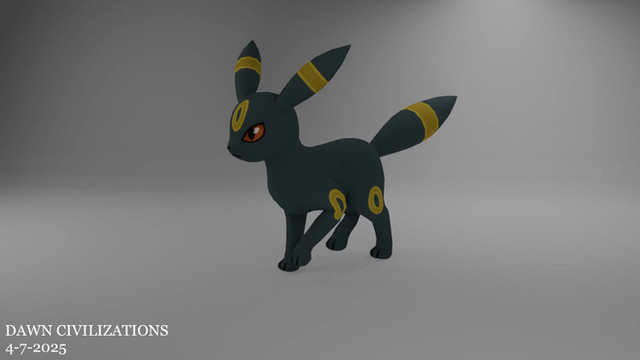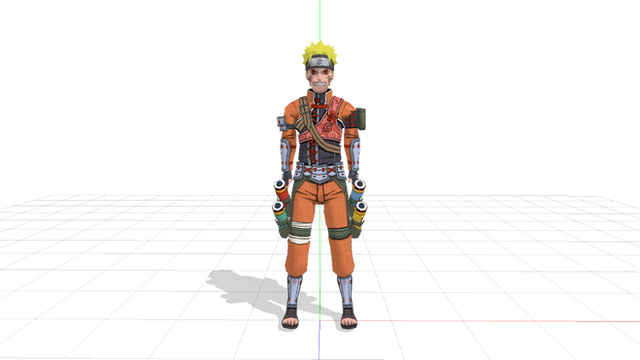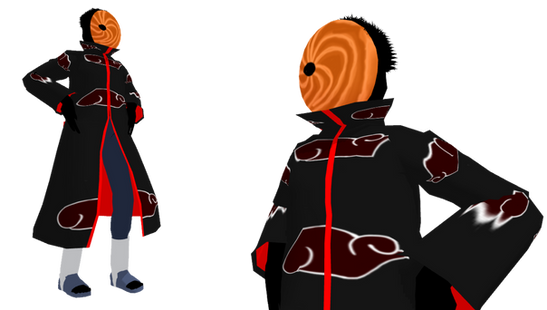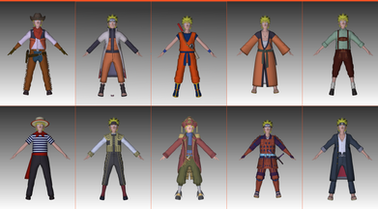HOME | DD
 MechaKraken — Low Poly Naruto Model Study
MechaKraken — Low Poly Naruto Model Study

Published: 2012-11-28 11:32:18 +0000 UTC; Views: 2832; Favourites: 0; Downloads: 101
Redirect to original
Description
Had some free time today, so I figured I'd experiment with something I always wanted to try - low poly modeling. These kinds of models are low in tris and polygons, so they are perfect for platforms such as cellphones and such. Also they are very quick to produce! This one took about 6 hours to complete. The model is 804 tris and 406 verts in construction. I was aiming at counts below 1,000 in each, attempting to make them as low as possible. I'm aware that even more tris and verts could be shaved off though, so my compliments to the fine artists that are capable of this!Btw, the character is Naruto. Ever since I read chapter 611, I've been wondering how it all will end! I'm rooting for all the heroes!!! Show that ten-tails who's boss!!!
Related content
Comments: 8

I would like to drop few critics, but Pirates already said what I wanted to say. However though, I'd like you to take a look at this link [link]
because I think what you are missing here is a topology study. Topology is about edge-flows (the direction your polygon is going through) and if you are able to study how to optimize your topology, you can practically reduce your polygon count (the purpose is doing a low poly character), while keeping the most important vertices sufficient enough for animating purposes (avoiding weird deformations during rigging).
Understanding what vertices are needed and what vertices are not needed, will result in a good low-poly character 
If you have further questions, I would gladly to provide answers and resources as much as I can help. Good luck on your future characters!
👍: 0 ⏩: 1

Wow, this is a great link you provided me Keichris! I see now that many current game models are low-poly, and the detail work is done by Zbrush right? I gotta get a copy of that. Topology like you mentioned is an artform in itself. I think I see now how to better use verts and tris. They gotta be meaningful, and each one used to the utmost. A single tri can accomodate what I was using 10 or 20 tris for. Thinking of the body with a wirenet over it helps sometimes too, I was told.
I wanna reiterate myself by saying that this is a huge revelation. What I once thought were high-poly models (100,000+ and up) in the games were really low-poly with high rez meshes from Zbrush. That's astounding. I feel like I have to rework my entire modeling strategy to include this new information, but that is ok. A modeler needs to keep up with current trends and be willing to adapt. I am willing! Thank you very much for your advice, I am hoping I can receive more critiques in the future from you when I post a new work. Thank you so much!
👍: 0 ⏩: 1

you're welcome 
If you're willing to invest some budget in this study, I recommend this tutorial [link] that actually taught me a complete workflow for game modeler nowadays. I learnt a great deal of knowledge from that single series (although their site also offer a hell lot of various tutorials). $45 per month can be costly, but think of it as an investment. That is, if you are serious in learning more from the professionals.
(I do think, that one single series is more than enough to understand the workflow of game modeler nowadays. I'm not saying the other series is unnecessary, but if you're tight on the budget, just that one will help a lot lol)
Cheers
👍: 0 ⏩: 0

I send thess exemples not for kidding you, but to show you exemples of very low poly architecture:
[link]
this pic is not mine. 450 tris! 2 time less and the character is more organique than yours.
[link]
this pic is not mine. 500 tris! less than yours.
[link]
this pic is not mine. almost the same as you! but each tris is usefull!! (and the texture sheet isn't large but have many details you didn't have)
keep working (with good technical referencies)
👍: 0 ⏩: 1

Wow, those are all amazing references you showed me Ked-V. I have to admit, I am perplexed, astounded, fearful, and awed all at the same time. But that is ok, because now I have an idea of the standard.
The last one you showed me was really awesome, in that the hand was fully functional, and the head was fully done. The entire mesh was one piece too. I need to redo my model, I bet with practice I could match him one day
👍: 0 ⏩: 0

You could have saved yourself a LOT of polies on this one, especially considering that the model is way too simplistic to be appealing.
Anyway, as for what polies you could have shaved:
-The polies on the torso area are almost unnecessary. With that few details, your character is probably not going to make a lot of movement. Hence, at the very least the extra iteration around the chest area is useless. That would have saved you approximately 28 tris.
-The ends of the sleeve should not have been connected to the hand. You should have made that part solid, and attach the hand seperately to the mesh. This would have saved you another approximately 32 tris.
-The same goes for the trouser legs; which would have saved you another approximately 32 tris.
-The headband area didn't need extra polies and could have been taken care off with just the texture. 12 tris.
There are a few more tris that could have been removed all over the body, especially in the areas that are not expected to bend. While we are talking about bending, let's get into why your model is not quite ready to be rigged.
For the moment, there are too few tris around the shoulder areas. If you would rig it now and animate the arms, they would cause flattening the closer they get to the body. You should always take into account the joints, as right now your character cannot even bend any of his limbs correctly when animating them.
When going into low poly modelling, the idea is more than just trying to get as little tris as possible. You should carefully plan what the model needs to be able to do and model according to that. That's exactly why effective low poly modelling is horribly difficult. Also, next time you create a low poly model, consider to make it feel more orchanic than this. Your model right now screams low poly; that's the one effect you want to avoid while modelling in low poly. Characters are not that blocky, for lack of better words. It is not a bad idea to start out with a fairly high polycount and start decreasing from there; it might actually be easier that way.
Anyway, good luck on your future modelling.
👍: 0 ⏩: 1

Wow, this is some fantastic advice you gave me PiratesAdventure. Thanks very much! To be honest, I was pretty nervous about venturing into low-poly, but upon following the advice of another artist, I decided it was time I went out of my comfort zone and dove right in. I guess sometimes one needs to be brave like that, regardless if the produced work is not very good. I have come to believe though that each picture we create enables us to get a little better, so if we produce a lot of pictures, we will eventually get a lot better
That's a great idea on making the hands and feet seperate objects. I know I've done that before, so I'm actually not quite sure why I didn't apply it to this model, where the technique would have been utilized the most. I notice that this technique was quite popular in the playstation 1 days. Games like Mega Man Legends and Alundra 2 used it. I think Final Fantasy 7 also used it for the field models (I heard those models were around 500 tris or less 0.0)
Your right about the joints. I usually try to make at least 3 edge loops around a joint in order to have it properly deform - one for the middle, and then one on either side. I was a little nervous about applying this method to a low-poly model though, for fear of adding too many tris. But as you stated, sometimes the most important areas for tris need to be addressed first, and beared in mind even before modeling begins. I'm gonna get rid of those chest polys, as I was thinking much the same thing you stated, about them being too numerous and unnecessary. When I think back on why I did that, I suppose I was adding loops so that I could get the back to have a natural curve. I'm sure there is a better way to accomplish this though.
I really appreciate your advice, as I'm trying to enter the industry and attempting to soak up as much info as possible. I remember first starting in 2007, then by 2009 I had given up for a while due to lack of opportunities. I picked it up again last march, when I decided that I can succeed if I want to, and that it is ok to fail at first, as long as I don't give up and keep trying. I know my modeling needs a lot of work, but I'm willing to go the distance in perfecting the artform so I can eventually get a job in the future. That's my dream, to be a part of the creative process in visuals for a film or game 
👍: 0 ⏩: 1

Well, practice makes perfect as they say!
Given that you mentioned FF7, it might be worthwhile to note that the inbattle models for FF7 actually didn't use joints, but used seperate primitives for all the body parts that needed to be animated. In those times, having bones was kind of heavy on the system I think, so they made due with that instead. If you look closely at Alundra 2, you can see they used the same system. Or at least, from what I remember of Alundra 2; it has been a while.
If I may give you a piece of advice. Low poly modelling is all good and well, but you also might want to look into using Zbrush or any other 3D sculpting program. If you really want to enter the industry, knowing this software is essential as most of the things these days, especially characters, get Zbrushed (for normal maps). There are tons of tutorials, amateur and professional out there regarding Zbrush, so it shouldn't be too hard to at least find some material behind it. If you have some money to spend, getting some of the DVDs at eat3D.com might also be worth your while, as they not only explain things like Zbrush, but they also have DVDs on modelling for today's kind of games.
Low poly modelling is a good way to get feel for detail as even with today's games, they still use models that are fairly low poly (maybe 5000 tris for those heavily detailed characters if I am not wrong). You should keep in mind however that there will come a time when the really low-poly models are not needed anymore; this time may come sooner than you think. Every platform major or small, safe for maybe the 3DS, is able to handle quite a bit. I have heard of the Unrealengine for instance handling scenes of up to 2-3 million polies without noticable slowdown.
👍: 0 ⏩: 0


























